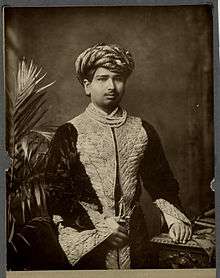Wadhwan
| Wadhwan | |
|---|---|
 Wadhwan  Wadhwan Location in Gujarat, India | |
| Coordinates: 22°42′N 71°41′E / 22.700°N 71.683°ECoordinates: 22°42′N 71°41′E / 22.700°N 71.683°E | |
| Country |
|
| State | Gujarat |
| District | Surendranagar district |
| Population (2011) | |
| • Total | 75,755 |
| Languages | |
| • Official | Gujarati, Hindi |
| Time zone | IST (UTC+5:30) |
| PIN | 363030 |
| Telephone code | 02752 |
| Vehicle registration | GJ-13 |
| Website |
gujaratindia |
Wadhwan is a city and a municipality in Surendranagar district in the Indian state of Gujarat.
Demographics

As of 2001 India census,[1] Wadhwan city had a population of 61,739. Males constitute 52% of the population and females 48%. Wadhwan city has an average literacy rate of 71%, higher than the national average of 59.5%: male literacy is 78%, and female literacy is 63%. In Wadhwan city, 12% of the population is under 6 years of age. From 1489 to 1947, the recurring Prime Ministers (Diwan) of Wadhwan State were always from the Rawal family whose descendants live there till date.
Geography
It is located on the bank of the dry River Bhogavo.
History
Wadhwan or Vadhwan city is a part of the Surendranagar district of Gujarat located about 111 km from the town of Ahmedabad, some 3 km distant from Surendranagar city. The town is situated on the banks of the Bhogavo River. Vadhwan is a known location for its old world royal charm and serene space with a life and culture of its own.
Vadhwan rulers belonged to the Jhala Rajput clans and had good administrative and culturally inclined society. To provide sufficient protection to their clan and the people, the town of Vadhwan was fortified and gates were erected at most places to provide safety. Some of these gates and the fortified walls are still found in the city, although city has grown beyond these walls. Vadhwan was the centre of the princely state by the same name, which in earlier days was known as Vardhamanpuri, the name being derived from the great Jain Thirthankaras, Bhagwan Vardhaman. The prime ministers of this princely state belonged to the Rawal family who were given the title of Dewan Bahadur. Under their rule, a number of important structures were constructed, mostly during the era of 18th and 19th century. Vadhwan is considered as an important centre for Jains and is renowned as one of the fortified towns of Gujarat. Formerly known as Vardhamanpuri, the town is believed to have footprints of Lord Mahavir. The Raj Mahal and Hawa Mahal were constructed here by the erstwhile rulers of the region.
The Raj Mahal was the residence of His Highness Balsinhji in 19th century, replete with exotic gardens, cricket pitches, fountains, tennis courts and lily ponds. The Raj Mahal is now functioning as a heritage hotel.
Hawa Mahal, 'the wind palace’ was built during the era of Jhala rulers. Even though it was an ambitious project with ultimate craftsmanship, the work was left incomplete. The part which is incomplete is outside the actual fort and is in different stages of construction along with the study of architectural designs, which were stopped midway. These give a glimpse into the style of architecture used by the artisans in erecting Hawa Mahal. In the present day also, many of the Sompura artisans whose community built Hawa mahal are seen involved in carvings and cutting of sculptures for various Hindu and Jain temple projects. [Sompura Salat community was one of the Brahmin communities in Gujarat who were master artisans. They built famous Somnath Temple. In recent years, these artisians have been called upon for restoration work of various temples in Gujarat as well as in other parts of India, and also building new temples.]
Vadwala Temple here is some 450 years old.
11th century Gangva Kund at Dedadara village is believed to have been constructed during the Chalukya period.
The popular ancient Gangavav step-well is believed to have been constructed in Vikram Samvat in 1969.
Madha Vav is popular for its historical significance. It is believed that the son and daughter-in-law of King Sarang Dev sacrificed their lives here for the natives of the region. The Automobile Library, Wagheshwari Devi Temple and Swami Narayan Temple are some of the prominent attractions located in the vicinity of Wadhwan.

During the British Raj, Wadhwan State was one of several princely states governed by the Jhalas. Mori Rajputs of Chittor had settled in Wadhwan city. It was classified as a 9-gun salute state.[2]
Education
C. U. Shah University is a private university located in Wadhwan city.[3] It is run by Vardhman Bharti Trust and named after Chimanlal Ujamshibhai Shah. It had been created by the state of Gujarat under the Private University Amendment Bill in 2013.[4][5]
References
- ↑ "Census of India 2001: Data from the 2001 Census, including cities, villages and towns (Provisional)". Census Commission of India. Archived from the original on 2004-06-16. Retrieved 2008-11-01.
- ↑ McLeod, John (1999). Sovereignty, Power, Control: Politics in the States of Western India, 1916-1947. BRILL. pp. 8–9. ISBN 9789004113435.
- ↑ "Private University Gujarat". UGC. Retrieved 20 September 2014.
- ↑ "A bill for setting up three private universities passed in assembly". DeshGujarat. April 1, 2013. Retrieved 20 September 2014.
- ↑ "Gujarat's prominent Philanthropist CU Shah passed away". Bilkul. January 31, 2013. Retrieved 20 September 2014.